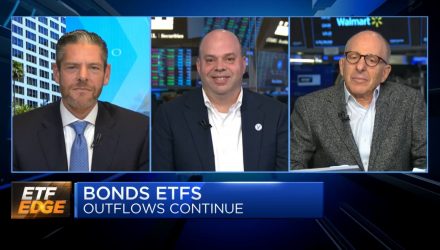Todd Rosenbluth, head of research at VettaFi; Jerome Schneider, head of short-term portfolio management and funding for PIMCO; and Dan Wiener, editor of the Independent Advisor for Vanguard Investors and chair at Advisor Investments discussed the about-face currently happening within bonds as inflows pick up for select bond ETFs after outflows for most of the year on this week’s “ETF Edge” hosted by Bob Pisani on CNBC.
It’s been many months of bleeding for bond investments this year as the Fed has begun its rate hiking cycle and embarked on quantitative tightening this month. After so many months of strong outflows, however, certain areas of bond funds are starting to see interest and investment once more.
Understanding the history and performance of the last decade is tantamount to understanding the changes happening in the yield curves, said Schneider. What’s currently going on in markets is a regime change with new bounds for bond performance being established, according to Wiener.
Bond-related mutual funds experienced outflows in the month of May, but bond ETFs actually saw inflows, a change that can be chalked up to more investors embracing the ETF structure, said Rosenbluth.
“We’re really seeing investors have more comfort in the choices they have within the ETF structure than they ever did beforehand; the liquidity is so much stronger if you want to be able to be more tactical with fixed income ETFs than you could with fixed income mutual funds,” Rosenbluth explained.
Inflows into bonds in May were seen for municipal bonds, high yield, and short-term Treasuries.
The Role of Active Management Within Fixed Income
Discussion moved onto the tax loss harvesting that is likely occurring within bonds right now as investors pivot from certain bond allocations into others or reduce their bond allocations and instead seek other avenues of investment, before shifting to discuss active versus passive overall and within fixed income.
“What we’ve seen is that active managers can add some value by taking on credit risk relative to the broader marketplace, and advisors are embracing that,” Rosenbluth said. “At VettaFi, we’ve done some surveys and done webcasts and talked to advisors to get an understanding, and what they’re telling us is they want an active strategy that can help navigate this environment that we’re in.”
There has been talk recently that the “Fed put” is no longer in place within equities and that even if equity markets fall dramatically, the Fed will not intervene. On the other hand, there is a belief by some that a “Fed put” within bonds exists to a degree, as it is in the best interest of the government to prevent yields from rising too high, Geraci said.
“I think what we need to be clear here is the initial discussion of liquidity of markets, and the Fed clearly has cut off its tails in the liquidity of markets in regard to making sure that fundamental liquidity is available in the repo market and, more importantly, trying to create mechanisms to make sure primary dealers are going to still be incentivized to take down primary issuance,” said Schneider.
Funds discussed included the iShares National Muni Bond ETF (MUB) and the iShares iBoxx $ High Yield Corporate Bond ETF (HYG).
For more news, information, and strategy, visit VettaFi.

